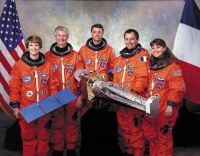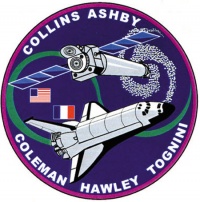STS-93
From The Space Library
 | |
| Organization | NASA-Office of Space Flight (United States) |
|---|---|
| Mission type | Astronomy,Engineering,Human Crew,Life Science,Microgravity |
| Launch date | July 23, 1999 |
| Launch vehicle | Space Shuttle |
| Launch site | Cape Canaveral, United States |
| COSPAR ID | 1999-040A |
| Inclination | 28.45 degrees |
| Experiments | Here |
| Alternate Names | 25866 |
| Additional Information | Here |
| Telecommunications Information | Here |
| Data Collection | Here |
| Payload Mass Up | 22583.91 kg |
| Payload Mass Down | 3049.55 kg |
| Orbiter | Columbia |
| Lift Off Mass | 2,056,805.45 kg |
| Orbiter Weight at Liftoff | 122,903.18 kg |
| Orbiter Weight at Landing | 91,971.82 kg |
| Landed | Concrete runway 33 at Kennedy Space Center, Fla. |
| Orbits of Earth | 80 |
| Orbital Altitude | 153 nautical miles (176 statute miles) |
Contents |
[edit] Crew
- Commander: Eileen M. Collins
- Pilot: Jeffrey S. Ashby
- Payload Commander:
- Mission Specialist 1: Steven A. Hawley
- Mission Specialist 2: Catherine G. Coleman
- Mission Specialist 3: Michael Tognini, Centre National d'Etades Spatiales (CNES)
- Mission Specialist 4:
- Mission Specialist 5:
- Payload Specialist 1:
- Payload Specialist 2:
ISS/Mir Crew Transport
[edit] Mission
The primary objective of the STS 93 mission was to deploy the Advanced X-ray Astrophysics Facility. AFAX was the most sophisticated X-ray observatory ever built. It was designed to observe X-rays from high energy regions of the universe, such as hot gas in the remnants of exploding stars. It was renamed the Chandra X-Ray Observatory in honor of the late Indian-American Nobel Laureate Subrahmanyan Chandrasekhar. "Chandra" also means "moon" or "luminous" in Sanskrit. Other payloads on STS 93 were: Midcourse Space Experiment (MSX); Shuttle Ionospheric Modification with Pulsed Local Exhaust (SIMPLEX); Southwest Ultraviolet Imaging System (SWUIS); Gelation of Sols: Applied Microgravity Research (GOSAMR); Space Tissue Loss-B (STL-B); Light Weight Flexible Solar Array Hinge (LFSAH); Cell Culture Module (CCM); Shuttle Amateur Radio Experiment-II (SAREX-II); EarthKam; Plant Growth Investigations in Microgravity (PGIM); Commercial Generic Bioprocessing Apparatus (CGBA); Micro-Electrical Mechanical System (MEMS); and the Biological Research in Canisters (BRIC). This mission also featured the first female shuttle commander, Eileen Collins. Columbia landed at Kennedy Space Center on July 27, 1999 at 11:20 EDT. The crew consisted of the following: Eileen M. Collins - Mission Commander; Jeffrey S. Ashby - Pilot; Steven A. Hawley - Mission Specialist; Catherine G. Coleman - Mission Specialist; Michel Tognini(CNES) - Mission Specialist.
[edit] EVA
[edit] Payload
Chandra X-Ray Observatory (CXO); Plant Growth Investigations in Microgravity 1; Southwest Ultraviolet Imaging System; Gelation of Sols: Applied Microgravity Research; Space Tissue Loss; Lightweight Flexible Solar Array Hinge; Cell Culture Module, Configuration C; Shuttle Amateur Radio Experiment II; Commercial Generic Bioprocessing Apparatus; Micro-Electro-Mechanical Systems; Biological Research in Canisters (BRIC)
[edit] Books about the Space Shuttle Program
Buy This Book Click here |
Buy This Book here |
Buy This Book Click here |
Buy This Book Click here |





